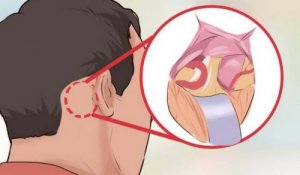5 Facts About Trigeminal Neuralgia, the Worst Pain in the World


Written and verified by psychologist Valeria Sabater
There are many different types of pain. As you may know, each is unique in its intensity and its characteristics. However, there’s one that’s commonly described as “the worst pain in the world”: trigeminal neuralgia.
In order to better understand this disease, we’ll talk about it in this article.
There are 12 pairs of nerves in your head. In some parts of the population, one of these nerve pairs can end up malfunctioning. This results in a condition that leaves the sufferer incapacitated. That’s what causes trigeminal neuralgia.
Trigeminal neuralgia has been around for centuries. In fact, it was described for the first time by Aretaeus of Cappadocia, as far back as the second century.
It’s characterized by a painful tic, which feels like an electric shock radiating through the entire facial area between the cheekbone and the chin.
It’s always useful to know as much as possible about the conditions that affect us. That’s why we want to take the time today to explain 5 key features of trigeminal neuralgia.

1. What Is Trigeminal Neuralgia?
Trigeminal neuralgia is a type of chronic pain caused by one particular nerve. Actually, it’s the nerve that gives the condition its name. The culprit is the fifth cranial nerve, which also happens to be the longest nerve in the head.
The condition takes the form of a severe tic. The tic can initially last for between two seconds and a whole minute. During this time, the sufferer is paralyzed and unable to chew or even speak because of the intensity of the pain.
When the condition first develops, the tics usually pass relatively quickly. Over time, however, trigeminal neuralgia can progress, leaving the patient suffering longer-lasting tics.
The nerve in question has three branches that cover the eye area, the scalp, the forehead and the front of the head.
This explains why people with trigeminal neuralgia typically experience pain in the jaw, the cheek, the lips, the teeth and even the gums.
A Blood Vessel is to Blame
The root cause of this condition and all the pain that comes with it is nothing more than a blood vessel.
- This vessel compresses the trigeminal nerve at the point where it leaves the brainstem.
- For this to happen, the protective sheath surrounding the nerve gets worn away. This is either due simply to the passage of time, or because of a disease that damages the nerve’s myelin.
- In turn, this progressive deterioration of the trigeminal nerve causes it to send abnormal signals to the brain.
The result? The most intense headache a human being can experience.
You might like to read: 5 Nutrients to Keep Your Brain Active and Healthy
2. Symptoms to Watch Out For
Episodes come on suddenly. They’re brief, but they’re so intense that they feel like an “electric shock.” At first, someone experiencing this may have no idea what has happened. Actually, they may even pay little attention since it passes so quickly.
Little by little, the attacks begin to occur more frequently. After a while, you only have to touch your face, chew, talk, or even brush your teeth to bring on an attack.
The attacks of pain last anywhere between a couple of seconds and an entire minute.
Some people will be affected by tics over several days. Then, they may disappear until the following month. Others will spend months in a row experiencing frequent tics.
The pain radiates through the cheeks, the jaw, the teeth, the gums, the lips and – though less frequently – the eyes and forehead, for reasons we explained above.
However, the pain usually affects only one side of the face. The attacks will normally become more frequent and more intense with the passage of time.
3. Who’s Usually Affected by Trigeminal Neuralgia?

Normally, people over the age of 50 are most commonly affected by trigeminal neuralgia. However, we shouldn’t forget that it can affect younger people, too.
The condition is more common in women than in men, and is often hereditary.
4. What Tests Will They Do on Me?
A positive diagnosis of trigeminal neuralgia is needed so doctors can differentiate it from other ailments (like migraines). The diagnosis is based on three key factors:
- The type of pain: If the pain is very short-lived, you can already be pretty certain that you’re dealing with trigeminal neuralgia.
- The location of the pain: Finding out which parts of the face are affected by the pain is a basic first step in diagnosing trigeminal neuralgia.
- What triggers the pain: This type of neuralgia is often triggered by light stimulation to the cheeks, as well as by chewing and talking.
Also read:
Once you’ve let your doctor know the answer to these questions, a specialist will be able to order the following tests:
- A neurological test
- An MRI scan
5. How Trigeminal Neuralgia is Treated

Pharmacological Treatments
No matter what, your doctor will always be the one who can point you in the direction of the most effective treatments. In this case, simple anti-inflammatory or analgesic drugs won’t do the trick.
- Anticonvulsant medications are used to block the function of the part of the nervous system that’s causing problems.
- Tricyclic antidepressants can also be effective when the pain is constant.
The Surgical Approach
If the drugs outlined above aren’t working, doctors may consider a surgical approach.
These can range from simple procedures to more complex operations, including the following techniques:
- Rhizotomy: This is a procedure in which certain nerve fibers are targeted and destroyed in order to block the abnormal pain signals.
- Balloon Compression: This is a simple and fast technique. To do this, surgeons insert a cannula, through which a small balloon is passed. This balloon compresses the trigeminal nerve to reduce over-stimulation and the pain this causes.
- Glycerol Injection: This is another technique designed to isolate the fibers of the trigeminal nerve, thereby preventing painful “electric shocks.”
Finally, in case none of the above tactics work, a procedure known as microvascular decompression is carried out. This is a more delicate intervention. However, it’s also the most effective of the options on offer. The best thing about it is that, once it’s competed, the trigeminal neuralgia won’t return.
So, while it may be the “worst pain in the world,” there’s no need to suffer forever. There is a solution.
No matter what, the most important thing is to remember to be patient. Follow quality medical advice and try a range of different options until you find the one that allows you to have the best possible quality of life.
All cited sources were thoroughly reviewed by our team to ensure their quality, reliability, currency, and validity. The bibliography of this article was considered reliable and of academic or scientific accuracy.
-
García, M. (2010). Neuralgia del trigémino. Servicio de Neurocirugía. Hospital Clinico San Carlos. Madrid. https://doi.org/10.1017/CBO9781107415324.004.
-
Santos-Franco, J., Santos-Ditto, R., Revuelta-Gutiérrez, R., Nacional de Neurología Neurocirugía Manuel Velasco Suárez Correspondencia, I., & Santos Franco, J. (2005). Neuralgia del trigémino. Arch Neurocien (Mex).
-
Robaina Padrón, F. J. (2008). Neuralgia del trigémino. Revisión del tratamiento médico y quirúrgico. Revista de La Sociedad Espanola Del Dolor.
This text is provided for informational purposes only and does not replace consultation with a professional. If in doubt, consult your specialist.








